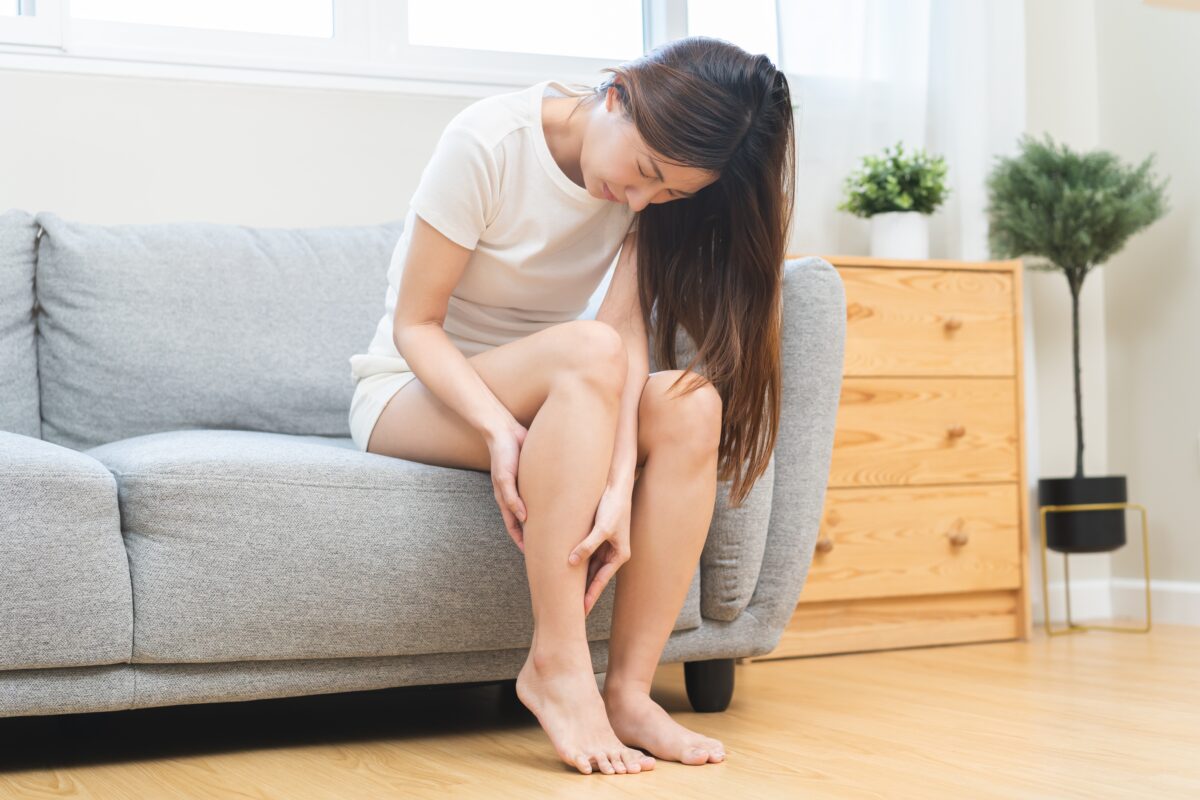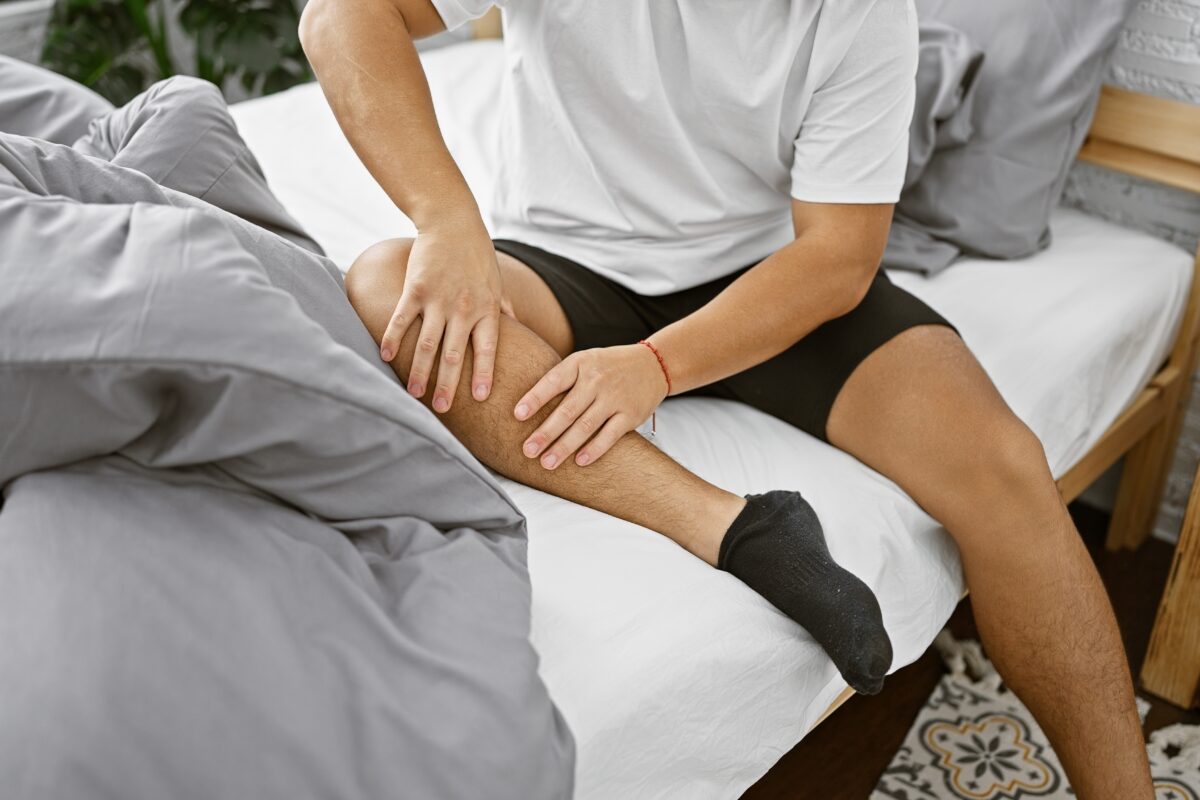Restless leg syndrome, also known as Willis-Ekbom disease or RLS, creates an uncontrollable urge to move your legs. According to the Journal of Orthopaedic Reports, this condition affects 4–10% of the general population.
Although the exact cause isn’t fully understood, lifestyle adjustments and medical care can ease RLS symptoms.
This article explains restless leg syndrome and outlines nine practical ways to manage it at home or with professional support.
Restless Leg Syndrome Explained
Restless legs syndrome is a neurological sleep disorder that affects the nervous system. It causes uncomfortable sensations in the legs that trigger an irresistible urge to move.
Common RLS symptoms include:
- Crawling, tingling, or pulling feelings in the legs
- Difficulty falling asleep or staying asleep
- An irresistible urge to move the legs for temporary relief
- Periodic limb movement during the night can make symptoms worse
RLS often develops in middle age and is more common in women. Children may also have early onset symptoms, but healthcare providers sometimes mistake them for growing pains.
In severe cases, symptoms can spread to the arms and disrupt daily activities.
Doctors consider RLS a lifelong condition for many patients, but treatment options and lifestyle changes can reduce symptoms and help people find relief.
9 Ways to Ease Restless Legs Syndrome Symptoms
Living with restless legs syndrome can be frustrating. Below are nine ways to reduce symptoms and improve sleep.
1. Improve Your Sleep Routine
Restless leg syndrome symptoms often flare at night, making it hard to fall asleep or stay asleep. Practicing good sleep hygiene can reduce the intensity of restless legs symptoms.
Try these simple habits each evening:
- Go to bed and wake up at the same time daily
- Keep your bedroom cool, dark, and quiet
- Limit screen time before bed
- Avoid heavy meals and caffeine late in the evening
These changes prepare your body for sleep and may lessen discomfort when symptoms appear.
2. Stretch or Do Light Exercise Daily
Regular exercise can help ease restless leg syndrome by keeping your muscles active. Gentle stretching before bed often prevents the twitching and pulling feelings that disturb sleep.
Try activities that don’t strain your body. Walking, yoga, or light cycling can relax muscles and support better rest. These movements may also prevent the muscle cramp sensations that sometimes mimic RLS.
Since restless legs are a movement condition, even small daily activities can help relieve the symptoms. Aim for consistency rather than intensity, and avoid heavy workouts right before bedtime.
3. Massage and Warm Baths
A warm bath before bed can relax your legs and calm restless sensations. The heat helps muscles loosen, making it easier to settle into sleep.
Massage is another effective option. Rubbing your legs improves circulation and eases the uncomfortable feelings linked with restless legs. Adding a heating pad afterward can extend the relief and keep your muscles relaxed longer.
These methods are simple home remedies that many people use to feel more comfortable at night.
4. Limit Caffeine, Alcohol, and Tobacco
Caffeine, alcohol, and tobacco can make symptoms of restless legs worse at night. Cutting them out of your evening routine often improves sleep quality.
These substances affect brain chemical activity and may interfere with how your body manages movement. They can also interact with certain medications or an underlying medical condition.
Try cutting back gradually. Replace coffee or alcohol with non-caffeinated options in the afternoon and evening to reduce nighttime leg discomfort.
5. Try Relaxation Techniques
Relaxation techniques can help calm restless legs by reducing tension and making it easier to fall asleep. Simple methods such as meditation, deep breathing, or gentle yoga before bed can support your routine.
Some patients benefit from practices often recommended in sleep medicine, like setting aside quiet time in the evening.
Joining a support group may also help, since sharing experiences can ease worries and offer encouragement.
These methods don’t cure restless leg syndrome but may ease discomfort enough to improve nightly rest.
6. Check and Boost Your Iron Levels
Iron deficiency is one of the most common triggers for restless legs syndrome. Low iron affects brain chemical activity that regulates movement, which can worsen symptoms.
A healthcare provider may recommend blood tests to measure your blood iron level. If the results show low iron, iron supplements or diet changes may help under medical supervision.
Correcting iron deficiency doesn’t treat every case of RLS, but it can reduce symptoms for many patients and improve sleep quality.
7. Try Over-the-Counter Supplements
Some people with restless legs find relief with over-the-counter options. Vitamins like magnesium or vitamin D may help ease uncomfortable sensations when taken regularly.
Supplements won’t cure restless leg syndrome, but they can support the body when no underlying cause is identified.
A healthcare provider may also suggest supplements when restless legs are linked to conditions such as nerve damage. Always check before starting new products to make sure they’re safe for you.
8. Consider Medical Treatments if Necessary
When lifestyle changes aren’t enough, medical treatments can help treat RLS. A healthcare provider may recommend a neurological exam to rule out other conditions before prescribing medications.
Several treatment options exist. Drugs that increase dopamine, such as pramipexole or ropinirole, may ease restless legs. Gabapentin enacarbil is another option often used for people with more frequent symptoms.
In some severe cases, doctors may prescribe low doses of opioids. Anti-nausea drugs or certain medications that calm the nervous system may also reduce discomfort. These options require medical supervision to manage side effects safely.
9. Get Support From a Specialist
A specialist can help you get restless leg syndrome diagnosed correctly. Many patients spend years treating symptoms without knowing the underlying cause.
Sharing your medical history and describing when symptoms occur gives your provider the information they need.
Doctors may also recommend a sleep study if they suspect sleep apnea or periodic limb movement disorder. In some cases, sleep apnea can be managed with oral appliances, which improve breathing and sleep quality.
New clinical trials continue to test treatment options, giving specialists access to the latest findings. Working with a professional makes sure severe RLS cases are managed with the right care plan.
When to See a Doctor About Restless Leg Syndrome
You should see a doctor if RLS symptoms worsen over time or if severe symptoms interfere with daily activities.
A healthcare provider can check for other conditions that commonly affect RLS, such as kidney failure or diabetes.
Women in the last trimester of pregnancy also face an increased risk of developing RLS, which often improves after delivery. Still, a doctor can suggest safe options for relief during that stage.
If you’re developing RLS at a younger age, or if home remedies don’t reduce discomfort, it’s important to seek medical advice. Early guidance can prevent symptoms from becoming more disruptive later.
Wake Up Feeling Refreshed With Wellness and Pain Care
Restless leg syndrome can make sleep difficult and leave you drained during the day. When RLS symptoms get worse, everyday routines become harder to manage.
Wellness and Pain offers treatment that alleviates the symptoms of restless leg syndrome. Our team provides pain management, chiropractic support, and neurologic testing to evaluate how the nervous system affects restless legs.
Vein treatments are available for heavy or cramping legs, and therapies such as massage and acupuncture help RLS patients rest better.
If restless legs are disrupting your nights, Wellness and Pain can help. Schedule an appointment and discover a treatment plan that helps you sleep peacefully again.
FAQs About Restless Legs Syndrome
How to alleviate restless leg syndrome?
Mild cases often improve with lifestyle changes. Regular exercise, a warm bath, stretching, and good sleep hygiene may bring relief. Some patients also benefit from massage or electrical stimulation to relax the muscles before bedtime.
What causes restless legs at night in bed?
RLS symptoms usually flare at night because the body is at rest and dopamine activity in the brain slows down. Low iron, certain medications, or underlying conditions such as kidney failure can also make symptoms worse.
What is the best medicine for restless leg syndrome?
There isn’t a single best medicine for everyone. Dopamine agonists such as pramipexole and ropinirole are often used, as well as antiseizure drugs like gabapentin enacarbil.
In severe cases, low doses of opioids may be considered under medical supervision.
What is the new treatment for restless leg syndrome?
One of the newest treatments for RLS is the FDA-approved TOMAC System from Noctrix Health. This wearable device sends gentle stimulation to the nerves in the lower legs, which can ease symptoms and help patients sleep better.
It’s often used for people who don’t get enough relief from medication and offers a non-drug alternative.












